As I’ve been talking a lot about ironclads lately, I’m going to discuss one of the weirder episodes of the Victorian Royal Navy. In that era, the most important force in the RN was the Mediterranean Fleet. It was tasked with defending the vital link between Britain and the Empire East of Suez from the French and Russians, Britain’s most probable adversaries in the event of war. The newest and best ships were sent there, as well as the ones with low freeboard, as the Mediterranean is considerably calmer than the Atlantic.
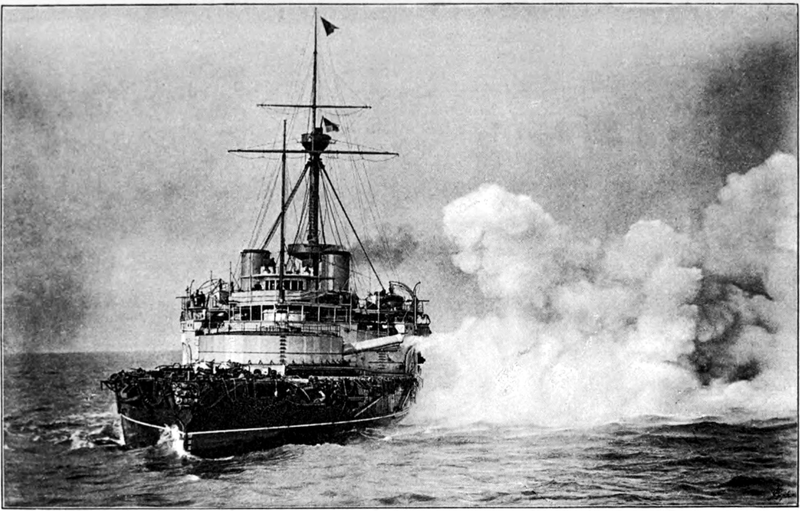
Victoria firing her guns
HMS Victoria was commissioned in 1890, one of the last classic turret ships built. She carried two 16.25” guns in a twin turret, the largest guns ever to arm a British battleship.1 The guns were not successful. Slow-firing and inaccurate, they could only fire about 75 rounds before needing to be replaced.2 Victoria was sent to the Mediterranean shortly after commissioning, and in 1893, she was still one of the most highly thought-of ships in the RN. Vice-Admiral Sir George Tryon, commanding the Mediterranean Fleet, chose her as his flagship.

Vice-Admiral Sir George Tryon
Tryon was a sharp contrast to the traditional image of a Victorian senior officer. He was an aggressive shiphandler, who refused to discuss maneuvers with his subordinates beforehand, but was also known to be very concerned with safety. During the 1888 maneuvers, testing the feasibility of blockades with steam warships, he had been placed in command of the “enemy” fleet. By harassing the blockaders and using clever tactics, he had managed to slip ships out of the Irish ports he was using for his bases, going on to ravage the British coast and force the defenders to concentrate on protecting only the Thames. While commander of the Mediterranean Fleet, he worked intensively to prepare his ships for war, focusing on realistic training.
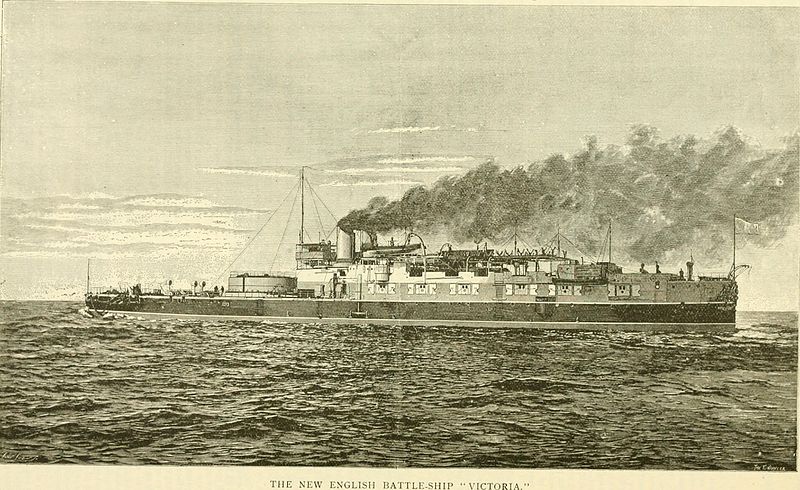
On June 22nd, 1893, the fleet was steaming in two columns, approximately 1,200 yards apart, preparing to anchor off Lebanon. Tryon ordered each column to turn 180 degrees towards each other, with the idea that the ships would end up going the other way, 400 yards apart. Unfortunately, the turn would take at least 800 yards laterally for each column, meaning that the maneuver should have started with the ships 2,000 yards apart. Because of Tryon’s reputation, his subordinates did not question this, apparently expecting him to order some other maneuver at the last minute.
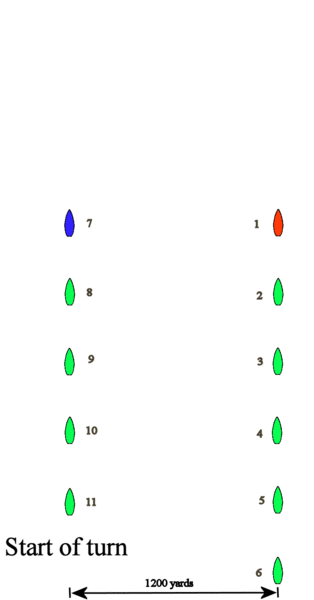
A diagram of the collision. Victoria is red, Camperdown blue
As the ships closed, it instead became obvious that Victoria, who was leading one of the columns, was on a collision course with another ship, HMS Camperdown. Both ships had their rudders hard over, and trying to turn the other way would have violated the rules of the road, creating the risk of yet more collisions. For various reasons, ramming was considered an important tactic in this period, and ships were designed with ram bows. As a result, when Camperdown struck Victoria, she tore a gash 28’ high and 10’ wide at the waterline, with the ram penetrating as much as 9’ into Victoria. In theory, only about 500 tons of water should have been able to enter the compartments opened by the collision, but the flooding spread quickly through doors and hatches that had not been secured. The crew could close all watertight doors in about 3 minutes during drills, but the command to secure them was not given until 1 minute before the collision. It was also discovered that the valves on the drain holes through the bulkheads were often jammed by debris, and could not be closed.
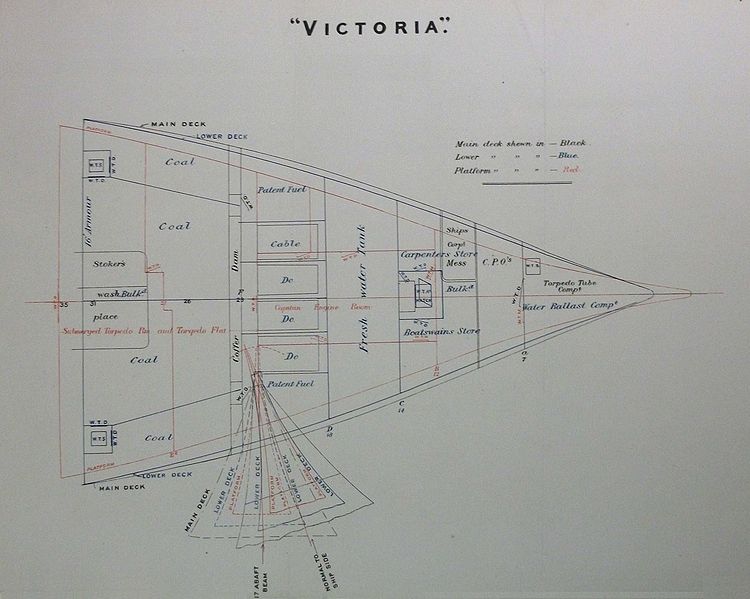
The damage to Victoria after the collision
Victoria normally had a freeboard of only 10’ forward, and it took only 4 minutes for the flooding to bring the bow under. Another 5 minutes saw the water beginning to pour into the ports of the turret, which flooded it and the 6” battery. However, the ship’s crew did not appear to recognize the urgency of their situation. The engine-room crew was never evacuated, and Tryon ordered other ships not to launch their boats, as he intended to ground Victoria to keep her upright and above the water. At 13 minutes after the collision, Victoria rolled over and sank, taking with her 358 of the 715 men onboard, including Admiral Tryon. The screws were still turning when they broke the surface. The best-known survivor was Victoria's executive officer,3 John Jellicoe, who we've met elsewhere.
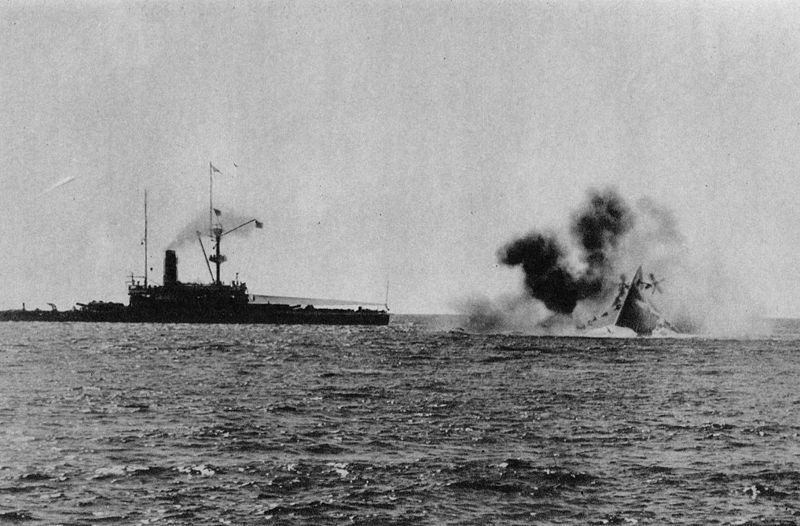
Victoria rolling over, with HMS Nile on the left
Because of Tryon’s death, his intentions in ordering the maneuver were never understood. Some suggest that he was simply mistaken, while others believed that Camperdown's commander was supposed to take avoiding action and misunderstood Tryon's signals. Camperdown survived despite extensive flooding, including some caused when an engineer opened the wrong valve and flooded several undamaged compartments. Later battleships were designed with fewer penetrations in bulkheads below the waterline, and to this day, RN ships secure all hatches before certain hazardous maneuvers, such as entering port. The wreck of Victoria was found in 2004, with her bow buried in the mud, and her stern high above the seafloor. This is an unusual state, nearly unique among shipwrecks.

Comments
In the second picture of Victoria (the postcard) what's the deal with...I'm not sure of the word, but notice how the hull is very tall from the bow through amidships, then very short where the turret is to the stern? This looks deeply weird to me (a lot of the pre-dreads do, I suppose.) Does it serve a purpose?
Even some of the early dreadnoughts seem to have high bows, like https://en.wikipedia.org/wiki/HMSTemeraire(1907) but to a much lower extent.
Andrew, you're looking at the ship backwards. The turret is in the bow.
The low turret ends with a high middle was reasonably common during this era. Compare with Nile, in the last picture. What makes it look so weird is that Victoria had only one turret. They needed to mount the secondary guns somewhere (and they're at about the same height as the main guns, just in the sides of the ship instead of on top) and that's also valuable space for habitability and seakeeping. I found in Conway's that the Victorias were considered to be better seaboats than the proceeding Admirals, but that the low freeboard forward made the turret hard to work.
As for exactly why she was designed that way, I'm not 100% sure. Oscar Parkes is excellent at what the ships were, but his interpretation of the design history is very, very Whiggish, and it's seeped over into a lot of other sources. He spends a lot of time damning the Victorias as retrograde steps compared to the Admirals, which I don't think is fair. DK Brown indicates that there isn't much documentation on their conception.
The best theory I have is that they were designed as coastal attack vessels for forcing the Bosphorus. This explains the single forward turret, the low freeboard, and the rather odd armor layout. But I obviously can't be sure.
Necro time! So Admirals have control over fleet maneuvers, but aren't there a lot of rules and etiquette about the captain's control over the flagship?
Captain Bourke was apparently absolved of all responsibility, but wasn't it his right and duty to command the Victoria, rather than having to repeatedly ask the admiral for permission to avoid the collision?
Those sorts of rules are dependent on era and Navy. I could completely believe that the rules were most in favor of the Admiral in the late Victorian navy. Also, Bourke may not have realized what the orders going to Markham were. I don't remember where he was during this whole episode. It's been a while since I read up on the details.
Re your footnote #1: HMS Furious.
Great website, I've learned a lot from it.
Wow. I have no clue how that happened, and am amazed it survived this long. Definitely know the difference between the two.
So as her final act, Victoria rammed the seabed?